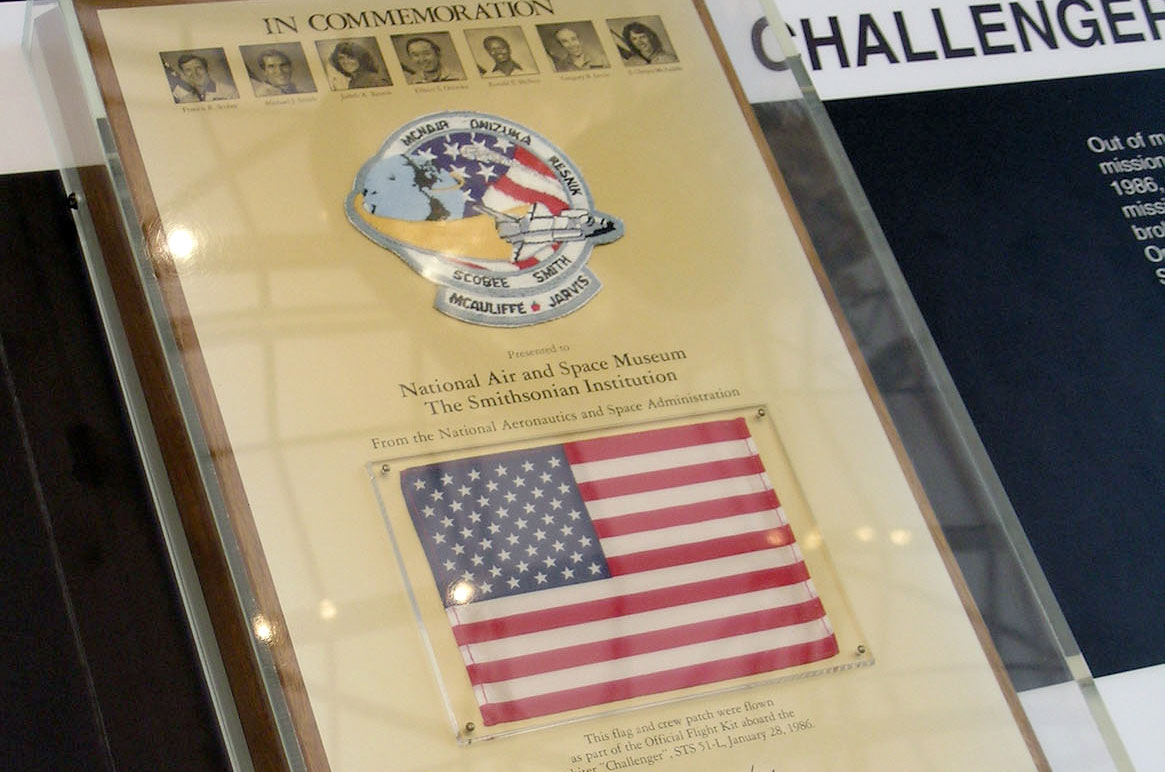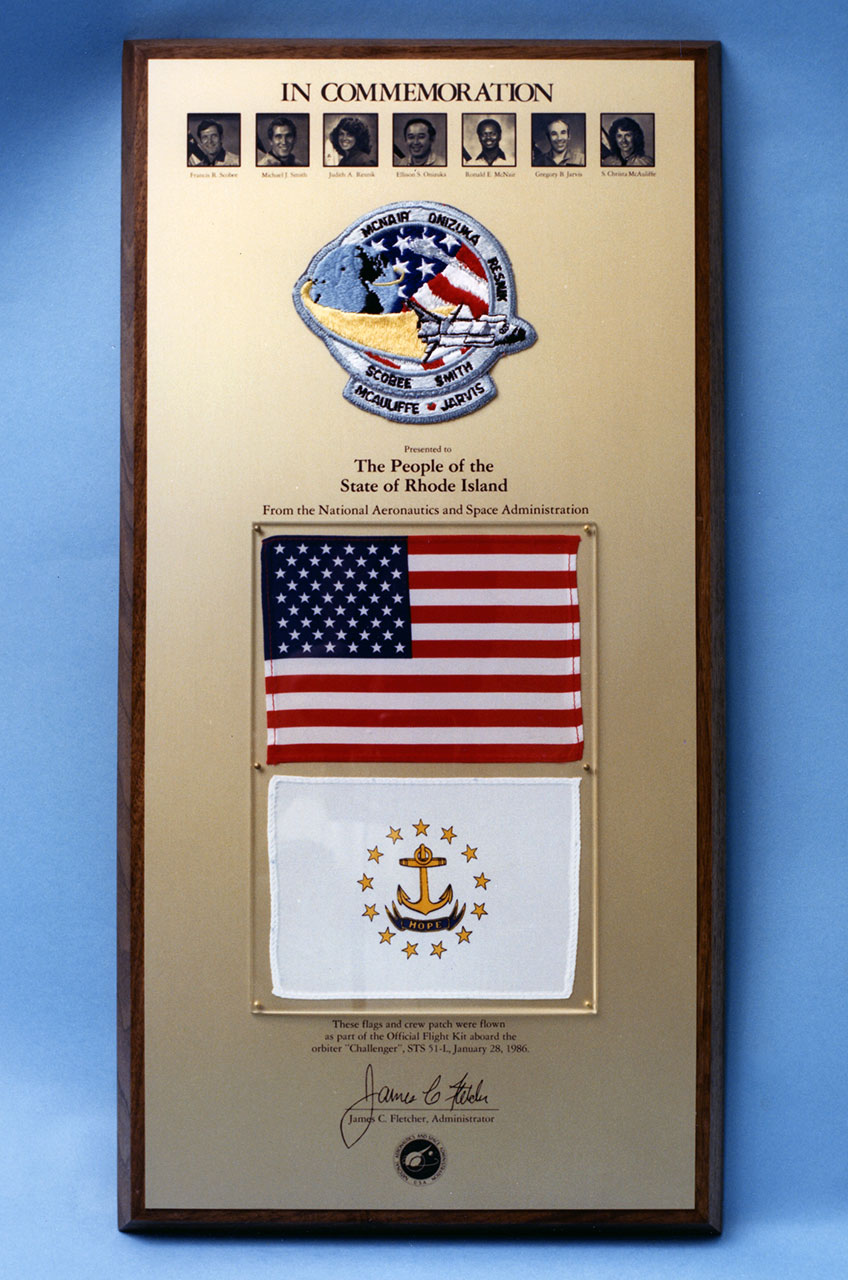Space Shuttle Challenger's Fallen Flags and Patches, 30 Years Later

The flags and patches were found the next day, floating in the Atlantic Ocean, among the debris from the fallen space shuttle Challenger.
The nylon banners and embroidered emblems, packaged in watertight pouches, were intended for NASA employees and other supporters of the 51-L mission, to be distributed after Challenger and its seven-member crew returned from orbiting the Earth for six days. Instead, 73 seconds into the flight, a problem with a solid rocket booster resulted in the Challenger breaking apart.
Originally put on the orbiter as mementos of NASA's 25th space shuttle mission, the flags and patches now took on a different role — as memorials for the astronauts lost in the U.S. space program's first tragedy during flight. [Remembering Challenger: Photo Gallery]
"This flag and patch were flown as part of the Official Flight Kit aboard orbiter Challenger, STS-51L January 28, 1986," read the walnut and aluminum plaques on which the flags and patches were mounted for presentation. Along the top of the plexiglas-covered displays were inscribed the words "In Commemoration" above portraits of the astronauts who died: Francis "Dick" Scobee, Michael Smith, Judith Resnik, Ellison Onizuka and Ronald McNair, Gregory Jarvis and S. Christa McAuliffe.
Eight months to the day after the loss, NASA announced it would distribute a flown STS-51L patch, an American flag and a state or territory banner to each of the 50 U.S. states and territories. The space agency did not direct where the plaques had to go, but made a request that the mementos be ''displayed appropriately in memorial to the crew."
Now, 30 years later, where are those plaques today?
Presenting the plaques
NASA had the STS-51L flag and patch displays produced in time for the first anniversary of the accident in January 1987. Plaques were then distributed to the states over that next year.
Breaking space news, the latest updates on rocket launches, skywatching events and more!
For example, astronaut Manley "Sonny" Carter presented the Challenger mementos to his home state of Georgia on Dec. 11, 1986. Governor Frank Harris accepted the plaque and said that it would be put on permanent display in the Capitol building in Atlanta, according to local news reports from that day.
Two months later on Feb. 19, 1987, NASA astronaut Ken Cameron traveled to Hartford, Connecticut to present Gov. William O'Neill with the state's STS-51L flags and patch.
"This plaque ... helps represent the spirit of exploration — the spirit the crew lived by, believed in and gave their lives for ultimately," said Cameron, who as a boy spent a part of his youth in Connecticut, reported the Associated Press.
The next month on March 23, astronaut Richard Richards was in Salt Lake City to present a plaque to the governor of Utah.
"These flags will serve as a reminder of the tremendous sacrifice made by the seven astronauts," Utah's Governor Norman Bangerter said, noting the plaque would be held in his office until it could go on display in the Capitol building.
A similar presentation was held in Idaho on May 1, 1987.
"It will be put in an appropriate place where it will be seen by the people who come to the Statehouse to visit," stated Gov. Cecil Andrus after astronaut Jim Adamson presented the plaque during a ceremony held in Boise.
Three decades later
Despite statements about permanent displays at the time, it is not clear where many of the Challenger flag and patch plaques are today.
Renovations to the buildings and just the passage of time may have contributed to some of the 51L memorials being relocated, statehouse representatives said. The curator for Utah's Capitol, for example, said that the plaque may have been exhibited in the building in the past, but after a 2004 restoration was no longer there.
A recent search for the Challenger plaques located only a few on public display, including:
- New York: In Garden City, at the Cradle of Aviation Museum
- Ohio: At the Armstrong Air and Space Museum in Wapakoneta
- New Mexico: At the New Mexico Museum of Space History in Alamogordo (currently in storage as the area where it previously hung is being renovated)
NASA prepared similar plaques for organizations that flew items on board Challenger. For example, a small "Learning and Liberty" flag that was to have been flown in space for the National School Public Relations Association is now at the Frontiers of Flight Museum in Dallas, Texas.
Similarly a plaque displaying flown STS-51L and Air Force Satellite Control Facility patches was at one time displayed at the Onizuka Air Force Station in California until it closed in 2010. (The base, which was earlier known as Sunnyvale Air Force Station, was renamed in 1986 for the Challenger astronaut, a Lieutenant Colonel in the U.S. Air Force.)
Perhaps the best known example of the memorial plaques is at the Smithsonian's National Air and Space Museum in Washington, DC. On exhibit in the "Moving Beyond Earth" gallery, which is devoted to the history of the space shuttle, it was joined by a similar flown patch plaque after the loss of space shuttle Columbia on Feb. 1, 2003.
Do you know where a Challenger memorial flag and patch plaque is displayed today? Click through to collectSPACE to let us know.
Follow collectSPACE.com on Facebook and on Twitter at @collectSPACE. Copyright 2016 collectSPACE.com. All rights reserved.

Robert Pearlman is a space historian, journalist and the founder and editor of collectSPACE.com, a daily news publication and community devoted to space history with a particular focus on how and where space exploration intersects with pop culture. Pearlman is also a contributing writer for Space.com and co-author of "Space Stations: The Art, Science, and Reality of Working in Space” published by Smithsonian Books in 2018.
In 2009, he was inducted into the U.S. Space Camp Hall of Fame in Huntsville, Alabama. In 2021, he was honored by the American Astronautical Society with the Ordway Award for Sustained Excellence in Spaceflight History. In 2023, the National Space Club Florida Committee recognized Pearlman with the Kolcum News and Communications Award for excellence in telling the space story along the Space Coast and throughout the world.


